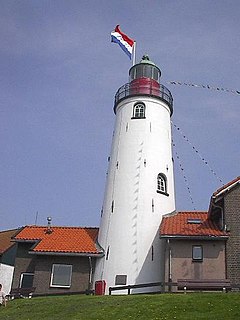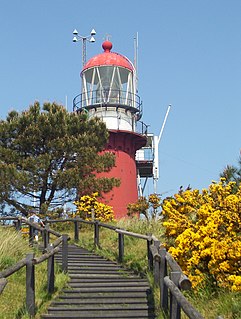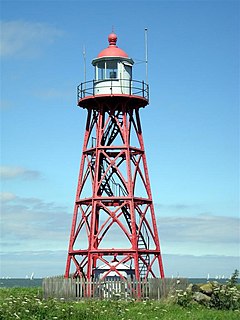
Middle Bay Light, also known as Middle Bay Lighthouse and Mobile Bay Lighthouse, is an active hexagonal-shaped cottage style screw-pile lighthouse. The structure is located offshore from Mobile, Alabama, in the center of Mobile Bay.

Sommers is an islet and a lighthouse in the eastern part of the Gulf of Finland, an arm of the Baltic Sea, just outside the Gulf of Vyborg, about 19 kilometres south of Virolahti, Finland, but it is now possessed by Russia. The lighthouse is situated on a rocky skerry, which is elevated a maximum of 16 metres above the Baltic Sea.

The Amrum Lighthouse is located in the southern part of the German island of Amrum, approximately 2 kilometres west of the village of Wittdün, yet still adhering to the municipality of Nebel. Its name in German is Seefeuer Amrum. The lighthouse is one of the island's landmarks, being open to the public during the summer season.

The Brandaris is a lighthouse on the Dutch Wadden Sea island Terschelling, in Friesland. It is the oldest lighthouse in the Netherlands, listed as a Rijksmonument, number 35032 and rated with a very high historical value.

Urk Lighthouse is a lighthouse in Urk at the eastern banks of the IJsselmeer. From 1617 a coal fire was used for the local fishermen as well as for the ships sailing from Amsterdam to the North Sea. The current lighthouse station was established in 1837. The tower was built in 1845 as a round brick tower attached to a keeper's house. A Fresnel lens is still in use. The lighthouse was restored in 1972 and declared a national monument of the Netherlands in 1982. The tower can be visited during guided tours.

Cape Bojeador Lighthouse, also known as Burgos Lighthouse, is a cultural heritage structure in Burgos, Ilocos Norte, that was established during the Spanish Colonial period in the Philippines. The lighthouse was first lit on March 30, 1892, and is set high on Vigia de Nagpartian Hill overlooking the scenic Cape Bojeador where early galleons used to sail by. After over 100 years, it still functions and serves ships that enter the Philippine archipelago from the north and guide them safely away from the rocky coast of the town.

Planier Light is an active lighthouse on the small Île de Planier, 13 kilometres (8.1 mi) from Marseille, Bouches-du-Rhône, France. At a height of 216 feet (66 m) it is the twelfth-tallest "traditional lighthouse" in the world.

Lange Jaap, also known as Kijkduin Light or Den Helder Light, is an active lighthouse near Fort Kijkduin in Huisduinen, Netherlands. At a height of 63.5 metres (208.2 ft) it is one of the tallest "traditional lighthouses" in the world. For almost a century, from 1878 to 1974, it was the tallest lighthouse in the Netherlands, until the construction of the Maasvlakte Light. According to The Lighthouse Directory it is the tallest non-skeletal cast iron lighthouse in the world.

Cape Bowling Green Light is an active lighthouse located on Cape Bowling Green, a lengthy headland ending with a long low sandspit, about 30 kilometres (19 mi) from Ayr, Queensland, Australia. The lighthouse is at the end of the headland, near the base of the sandspit. The first lighthouse at the location, established in 1874, was moved multiple times. It was prefabricated in Brisbane, shipped to the location, moved twice due to coastal erosion and finally transferred for display at the Australian National Maritime Museum at Darling Harbour in Sydney.

The Ameland Lighthouse, commonly known as Bornrif, is a lighthouse on the Dutch island Ameland, one of the Frisian Islands, on the edge of the North Sea. It was built in 1880 by order of William III of the Netherlands. It was designed by Dutch lighthouse architect Quirinus Harder and built by the foundry Nering Bögel in Deventer. The individual segments were shipped to Ameland and welded together on-site.

Vuurduin is a lighthouse on the Dutch island Vlieland. The tower is the top part of the former front light of the leading lights in IJmuiden, designed by Quirinus Harder.

The North Tower is the unofficial name for one of the lighthouses on the Dutch island Schiermonnikoog, one of the Frisian Islands, on the edge of the North Sea; the other is the South Tower. It was built by H.G. Jansen & A. van Rhyn, and was activated in 1854. From the tower, weather reports are issued for the coastal waters. In 1998 it was painted red.

The Stavoren Lighthouse is a lighthouse near Stavoren on the IJsselmeer, in the Netherlands. On two nearby piers are a red and a green light beacon for the Stavoren harbor. All were built in 1885 and are Rijksmonuments since 1999. The lighthouse was restored in 2001.

The J.C.J. van Speijk Lighthouse is a lighthouse on the North Sea coast near Egmond aan Zee, in the municipality of Bergen, North Holland, in the Netherlands. The foundation of the lighthouse, shaped like a tomb, is the official Dutch memorial to Jan van Speyk, a hero to the Dutch people.

The Paard van Marken is a lighthouse on the Dutch peninsula Marken, on the IJsselmeer. It was built in 1839 by J. Valk. A primitive lighthouse had been on the location since the early 18th century; the current lighthouse has been a listed building (Rijksmonument) since 1970.

De Ven is a lighthouse in Oosterdijk, a village in the municipality of Enkhuizen, Netherlands. Built in 1699–1700, it is one of the oldest lighthouses in the Netherlands.

Vuurtoreneiland is a small island in the IJmeer, Netherlands, just off the coast of Durgerdam. The island's main function is as a base for a lighthouse; a military fort on the island was abandoned in the 1930s.

Nieuwe Sluis is a Dutch lighthouse in the Nieuwesluis community, a few kilometres west of Breskens, Zeeland, and the southernmost in the country.

The Westerlichttoren or West Schouwen is a lighthouse in Haamstede, Netherlands. Designed by L. Valk, it was built in 1837. At 47 m above ground and a light stand at 58 m above sea level it is one of the tallest lighthouses in the Netherlands.

Grönskär is a Swedish island and lighthouse station located in the south Stockholm archipelago, east of Sandhamn. The island is rocky and the nature sparse. The herb cloudberry has been found on the island. The whole island is owned by the Swedish foundation "Skärgårdsstiftelsen". since 1964. The foundation also owns the lighthouse since 1984.


 FL(2) W 10s
FL(2) W 10s























